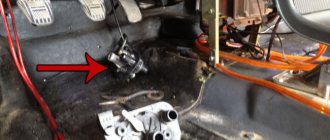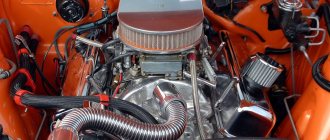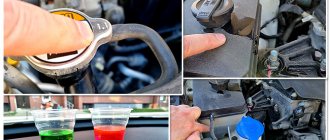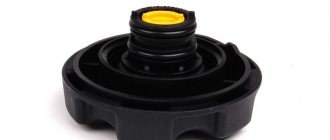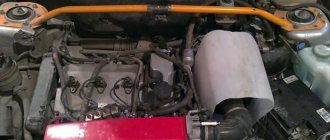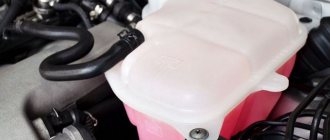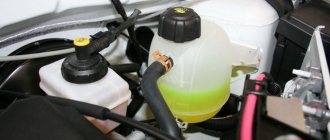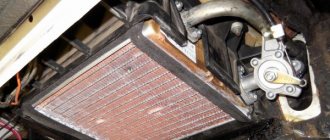One of the unpleasant problems that every car owner may encounter is when antifreeze is thrown out of the vehicle's expansion tank. To avoid panic, let's consider what are the causes, signs and consequences of such a breakdown.
- 2 Why is antifreeze thrown out of the cooling system?
- 3 Antifreeze is leaving - main and side signs
- 4 Antifreeze is squeezed out of the system - what are the consequences?
- 5 How to avoid damage to the expansion tank?
How to remove an air lock from the cooling system Simple methods
- After filling or adding new fluid;
- Due to depressurization of connections or pipes of the cooling system;
- The seal of the pump is broken due to worn seals and gaskets;
- Sticking air valve in the expansion tank;
- Mechanical damage due to an accident or traffic accident;
- Deformation of the polymer material due to constant elevated temperature;
- The cylinder head gasket has blown.
Why does the coolant level rise?
The liquid itself does not really change volume. However, all car owners know that there are two level marks on the expansion tank: hot and cold. Most often these labels are designated “MAX” and “MIN”.
The container itself is designed in such a way (we are talking about a working system) that when the level increases, the antifreeze should not splash out, and when it decreases, air jams should not form in the system.
What causes the volume to jump:
- Most of the system is located inside the cylinder head. When heated, the metal increases in volume, and accordingly, the antifreeze cavities are compressed. When fully warmed up, the volume of the cooling jacket may decrease by up to 10%;
- Air bubbles form inside the water pump. This phenomenon is called cavitation. During circulation, the total volume of liquid (with air) increases;
- Local boiling of antifreeze may occur on the walls of the cylinder liners (especially if the liquid has lost some of its performance characteristics). Due to the steam bubbles, the total volume increases again.
Even after the engine has stopped completely, the antifreeze usually stays on for a long time. You can then watch the level in the reservoir gradually decrease to the “MIN” mark.
A closed cooling system has many connecting flanges that have a tensile strength. If there is excess pressure, the connection may lose its tightness. Of course, antifreeze leaves through such points.
To relieve pressure, a plug with a valve is installed in the expansion tank. Excess air is released, and the system is not destroyed. However, car owners often encounter malfunctions in which the cooling system releases antifreeze.
Some tips on what to do if antifreeze boils on the road
How to fix an antifreeze leak If you find yourself in the middle of a highway or there is no car service or auto parts store nearby, the first thing that comes to mind is to add water to the antifreeze. This can really save the situation, but you need to be extremely careful with this operation. Never open the expansion tank cap until the engine has completely cooled down. Otherwise, boiling liquid may splash onto your hands and body, causing severe burns.
If while driving you notice a jump in the antifreeze temperature, you can temporarily solve this problem without stopping. To do this, you need to cool the car interior as much as possible by opening the windows and turning on the heater fan. Thanks to this, you will be able to slightly lower the temperature of the antifreeze and reduce the load on the engine.
Consequences of throwing away antifreeze
If you do not take any measures to eliminate the malfunction and continue driving, the consequences of such driving can be quite serious. If the antifreeze is squeezed out of the tank to a level below the minimum, the engine will simply overheat.
The consequences of engine overheating are very sad. As a rule, the cylinder head gasket is the first to suffer. It consists of a material that is susceptible to high temperatures and burns through, losing its properties. Antifreeze gets into the engine crankcase and makes the oil too liquid. Such a mixture will no longer be able to provide reliable lubrication of the components and then jamming of the mechanism or water hammer occurs.
If the coolant is completely squeezed out, the engine oil will not be affected. However, many elements of the cylinder head can react negatively to an increase in temperature, which become deformed and disrupt the operation of the mechanism. As a result, the engine loses its power or does not start at all and then it will require expensive repairs.
What to do if antifreeze boils
If you notice that the antifreeze has begun to boil, it is better to identify the root cause as quickly as possible, as this will have a detrimental effect on the operation of the engine. Although the boiling point of antifreeze is higher than the boiling point of water, the refrigerant still periodically fails to cope with too heavy loads
There can be many reasons for this, for example:
- The coolant level has dropped to a minimum due to which the antifreeze in the expansion tank is boiling. In this case, it is enough to add refrigerant or water.
- The thermostat can also cause boiling if the valve that passes fluid through a large circle of the cooling system is broken. In this situation, it turns out that the antifreeze moves only in a small circle and does not physically have time to cool down, as a result of which it heats up to a high temperature and begins to boil. To identify such a problem, you need to check the temperature of two pipes; if one of them is cold and the other is hot, then the problem is clearly in the thermostat. A thermostat malfunction is a very serious failure, since when antifreeze circulates only through a small circuit, not only the antifreeze, but also the engine itself heats up, and this threatens to jam the piston group.
Advice! If the thermostat “flies” outside the city and there is no way to replace it, you can continue driving in small sections of 5 kilometers. After each section, allow the engine to cool completely.
Burst of hoses and damaged pipe is a problem that requires quick fix
What antifreeze to choose, choice by car make, orange antifreeze
For old cars with hundreds of thousands of miles on them, the problem of antifreeze leakage is most often worn out hoses. Over time, they lose their elasticity, crack and no longer withstand constant pressure. Its fastening at the junction also loses strength and weakens, which can lead to antifreeze leakage.
Advice! For preventive purposes, it makes sense to change the cooling system hoses after about 5 years of operation (for foreign cars - 10 years), and use screw clamps for fastening.
It is not difficult to find out that the hoses are the reason why the antifreeze quickly disappears. A careful inspection is enough. If obvious damage is clearly visible, then in order to identify small defects, you must first thoroughly rub all the hoses with a dry rag and run the engine at idle speed. After this, coolant leaks become clearly visible.
In some cases, it is necessary to carry out an operation to replace worn pipes. When performing this procedure yourself, you should follow certain recommendations:
- The car engine must cool completely;
- It is better to use a clean container to drain antifreeze, since it can be reused and can be poured back into the system;
- to make it easier to unscrew the clamps, you can lubricate them with a small amount of liquid oil or another product (for example, WD-40);
- after loosening the clamps, the pipe is carefully removed from the neck, remembering that almost all necks are quite fragile and easily damaged;
- Before putting on a new pipe, clamps are put on it;
- if difficulties arise when tightening a new pipe, you should not use any chemicals, it is only permissible to hold the pipe in hot water;
- The clamps are tightened tightly.
Triggering of the safety valve - causes and consequences
As just said, the reason why antifreeze is thrown out of the expansion tank of a VAZ 2114 is most often a leak in the engine cooling system. It leads to air leaks into the line or, conversely, prevents normal coolant circulation and cooling. This, in turn, causes the liquid in the tank to boil and be squeezed out through the safety valve of its lid.
Expansion tank cap for VAZ 2114
The main reasons for this may be:
- Factory defects in the tank.
- Microcracks in pipes.
- Blockages or cracks in the radiator.
- Water pump malfunction.
- Thermostat malfunction.
- Burnt out cylinder head gasket.
Inspection of the tank
You should start troubleshooting small, namely, by inspecting the tank, all hoses and pipes of the cooling system. If cracks or coolant leaks are noticed on them, they should be replaced.
Antifreeze presses out from under the lid of the VAZ 2114 tank
Tank check
Another reason is a defect in the tank itself. It can burst, both after several years of use and after a week of driving the car. Low quality plastic, constant high pressure - and you have a crack in the tank through which antifreeze leaks.
Have you made sure that the expansion tank is intact, but still don’t know why it is throwing out antifreeze? Another reason for the constant “loss” of antifreeze is overheating of the car. Constantly high engine temperature, improper operation of the radiator, malfunction of the pump - the antifreeze simply boils.
Car oil in antifreeze
The opposite also happens. When motorists see traces of grease on the walls of the expansion tank, they ask themselves the question: “Why is there oil in the antifreeze?” The car oil from the lubricating complex somehow ends up in the cooling system, but everything is fine with the oil liquid. Its volume, shade, viscosity do not change.
Experienced drivers in such situations say: “The end of the cylinder block.” Usually these words are true. Through a crack in the block, part of the lubricant enters the cooling complex and curls up there. An emulsion is formed. It is almost impossible to replace the cylinder block on your own. You must contact a specialized service center.
Antifreeze is leaving - main and side signs
Now everything is clear with the reasons, but how can you understand that coolant is being thrown out of the system? Antifreeze evaporates very quickly, so it is not always possible to catch traces of it, especially if it leaves in small quantities . Of course, when a lot of liquid is squeezed out through the expansion barrel at once, characteristic puddles will remain on the asphalt. Well, in general, you just need to observe the behavior of your “iron horse”; it will indicate in the best way possible a particular malfunction.
So, in cases where doses of antifreeze are squeezed out of the expansion tank all the way into the cabin, a characteristic sweetish smell will appear there. But when clouds of white smoke come out of the exhaust pipe, then, most likely, the coolant goes into the car engine. The most unpleasant situation that can happen is that liquid gets into the engine crankcase, as a result of which the latter can fail. A sign of such a malfunction is the formation of a white emulsion on the surface of the oil filler cap. In addition, sometimes check the condition of the space under the belt cover; increased humidity indicates an antifreeze leak under the timing belt due to pump failure.
You can understand that antifreeze is already boiling in the expansion tank by the following signs. Firstly, the temperature needle will rise abruptly to 130. Secondly, white foam will form on the filler neck. Thirdly, the engine will stop functioning. Fourth, the coolant level will rise sharply. In this case, white smoke will come out of the exhaust pipe. All this should not only alert you, but also prompt you to take action immediately. Why? Let's take a look below!
How to detect loss of antifreeze?
You know the reasons for the release of antifreeze, but how can you tell if the coolant is not being used for its intended purpose? Antifreeze itself evaporates quite quickly and does not leave obvious traces, especially if there is not a lot of it. If you constantly use the car for its intended purpose, you will definitely notice this malfunction.
- If a lot of coolant is lost, marks (stains) remain on the asphalt.
- If the antifreeze reaches the interior, a specific smell begins to appear, a little sweetish. The thermostat may be broken or there may be problems with the gaskets.
- White smoke from the exhaust pipe - check the engine. It is very possible that the antifreeze went there.
- White emulsion on the oil filler cap.
The latter option is a death sentence for the engine.
, because means that antifreeze has entered the engine crankcase. Direct route to the service station if you value engine integrity. In addition to all the above points, pay attention to the belt cover. If there is high humidity underneath, check the pump. It is possible that the leak occurs due to its breakdown.
Troubleshooting
Troubleshooting must begin with an analysis of the characteristics of its manifestation.
When idling
The coolant in the distribution tank behaves normally, but when the speed increases, it begins to rise and is knocked out, then we can speak with confidence about the following causes of failure:
- loss of tightness in the pressure relief valve;
- thermostat failure;
- pump breakdown;
- pipe rupture.
When the cylinder head gasket breaks, antifreeze will be knocked out even at idle, regardless of the engine operating mode.
The easiest way to determine
such a breakdown is to look at the smoke from the exhaust pipe. If smoke comes with white steam, you can be sure that antifreeze is leaking into the cylinder head.
If liquid drips from a pipe, then the most advanced motorists taste it. If the water tastes sweet, then it is antifreeze, if the water tastes bitter, it is antifreeze, the taste is neutral - ordinary condensation.
The reasons for the situation when antifreeze is knocked out of the expansion tank may be a breakdown of any unit involved in engine cooling
. If this is damage to the cover or the pressure relief valve built into it, then you can fix such a breakdown yourself by replacing the cover with a working one.
A little about the problem
The expansion tank is an integral component of the internal combustion engine cooling system. The main task of this element is to dampen pressure fluctuations inside pipelines that arise as a result of a decrease or increase in the volume of cooling liquid when it is cooled and heated, respectively.
Such a capacity allows you to reduce mechanical loads on the entire cooling system. Thus, the internal combustion engine is protected from water hammer and air locks. Although they cannot be completely prevented, as a result, sometimes you have to figure out how to remove the airlock. Essentially, the tank replenishes the liquid deficit in the cooling lines and acts as a receiving tank when excess coolant appears, which occurs when the composition is heated. Structurally, it is a seemingly ordinary sealed plastic tank.
An integral element of the unit is the expansion tank cap, which also serves as a valve. With its help, pressure enters the tank from the outside when there is a deficiency in the system, or excess pressure is released.
When the coolant heats up, the liquid gradually expands, thereby filling the tank space. In parallel with the increase in evaporation from heating, the internal pressure increases. For various tank designs and specific car engines, along with their cooling system, certain threshold pressure values are provided. When they are reached, a valve begins to operate, which expels excess pressure from the system. But there are situations when the antifreeze is already boiling, the pressure increases, but it does not release. Instead, it throws out the liquid itself. That is, the valve does not cope with its tasks. Why this happens and how to deal with it is the key question of this material.
Moreover, emissions can appear after the engine is stopped and during operation of the power plant. Let's understand the reasons.
What not to do when the engine is boiling
There are a number of strict rules that limit the driver’s actions during a situation when antifreeze boils in the radiator, expansion tank or other element of the cooling system. These rules are designed to protect human health from causing serious injury, and to minimize material losses that may arise in the described situation.
- Do not load the engine (do not accelerate, but instead you need to reduce the speed to idle as much as possible, usually around 1000 rpm).
- Do not stop abruptly and turn off the engine, thinking that the engine will stop boiling; on the contrary, everything will only get worse.
- Do not touch hot parts in the engine compartment!
- While steam is coming from under the cap of the expansion tank or other unit and while the antifreeze is bubbling in the system, you should absolutely not open the cap of the expansion tank! This can only be done after the time specified above has passed.
- Do not pour cold water on the engine! You need to wait for the engine to cool down on its own.
- After the engine has cooled down and new antifreeze has been added, you should not drive after the temperature reaches more than +90 degrees.
Compliance with these simple rules will ensure the safety of the driver, and also minimize the degree of breakdown and, consequently, possible material costs.
Increased pressure or temperature in the cooling system and, as a result, knocks the antifreeze out of the expansion tank, and the car is covered in a cloud of steam. The situation is unfortunately familiar to many motorists. Regardless of the car brand, the principle of cooling the propulsion system is the same for everyone. Typical faults are also similar.
Antifreeze leaks from the expansion tank for many reasons, and most of them are directly related to the cooling system, but can also be caused by a violation of the vehicle’s operating conditions.
If antifreeze ejects from the expansion tank - reasons
When operating a car, it sometimes happens that antifreeze is released from the expansion tank, protecting the engine from extreme temperatures. It consists of glycone ether, whose boiling point is at +197°C, and specially selected additives, without which the properties of antifreeze deteriorate sharply. The coolant does not change its declared properties at any operating parameters, and its presence in the system does not have a destructive effect. Antifreeze can vary in its composition and temperature limits, usually varying in the range of 108...135°C, and sometimes reaching +197°C.
Antifreeze poured into the tank enters the engine through pipes and the radiator. When heated, the liquid expands and is partially converted into steam, which is removed from the system through a hatch in the expansion tank cap. Antifreeze is thrown away in the following cases:
- The main reason lies in the natural wear and tear of the cooling system. The appearance of cracks in rubber tubes caused by natural aging leads to their depressurization. As a result, a decrease in coolant volume is observed, causing overheating of the cooling system caused by depressurization of rubber tubes. Under the influence of increased pressure, antifreeze is thrown back.
- The defect may be hidden in the cap of the expansion tank. Considering the fact that the market is overflowing with defective products, one of the installed parts may include a faulty tank with a lid. First of all, you need to check the threads, which may contain chips and burrs. Their presence directly affects the tightness of the connection and the possibility of antifreeze leakage.
- If the walls in the expansion tank do not meet the standards, then they will not withstand high pressure and the liquid will pour out.
- Antifreeze can also splash out when it boils, which occurs when the thermostat breaks down, there is insufficient antifreeze volume, or when the fan is broken.
- Over time, the reliability of the fastening of the pipes connected to the expansion tank drops sharply. As a result, the liquid will be squeezed out at the bottom of the container.
In order not to bring the system to a critical state, it is necessary to pay attention in time to symptoms indicating problems. These include:
- accumulation of antifreeze under the bottom of the car in the form of a puddle,
- soaking liquid into the interior. This picture is typical for broken taps that need to be replaced;
- the presence of antifreeze in front-wheel drive models can be detected under the timing cover. Its traces indicate that it is time to change the water pump.
- the presence of characteristic fumes in the exhaust pipe, determined by the color of the smoke and wet spots on the paper. The answer lies in a bad gasket located in the cylinder head, through which antifreeze leaks into the exhaust system.
Real cases of malfunctions.
Oleg, VAZ 2114:
I noticed that when the engine is running, even to warm up, antifreeze presses through the plug. The fluid level also dropped, so I had to top it up periodically. I started looking for the problem. It turned out that the pump was at fault. Upon inspection, I saw that the timing belt protective cover was wet from the inside, and threads appeared on the block on the timing side. Thanks to the broken gasket of the water pump, the casing and block were splashed, and at high speeds after the engine warmed up, the coolant almost boiled and was thrown out through the valve. Since I took the car by hand, I didn’t bother to rebuild the pump - I installed a new one, now it doesn’t throw away and it’s dry.
Nikolay, Gazelle 4216:
There is a problem. Gazelle 4216, UMZ engine, new thermostat. When the engine warms up, everything is fine, it reaches operating temperature and the antifreeze begins to flow through the plug. The engine never overheated. I thought it was a crack in the head, but the oil level is normal, the antifreeze is clean, the fan works like a charm. Replacing the valve cover did not help. A thorough search for the cause at the service center showed that the gasket in the cylinder head had broken. The master said that the disease is known - it needs to be polished a little. It can be worse - often there are microcracks in the head, the beam should be changed immediately.
Peter, Chevrolet Niva:
I noticed that coolant drips constantly appear around the plug and under the reservoir on the body. I read descriptions of faults on the Internet and started looking everywhere I could. I didn’t find it - everything is normal, but the streaks remain. I took the car to the service center.
The master enlightened me - it turns out that this is a common occurrence on this machine. When the pressure is released, especially when the engine is warm, the antifreeze flows out in an intense stream with splashing. As a result, some of the coolant splashes out. The process is repeated constantly when driving, splashes appear through the hole in the plug and numerous drips appear.
He solved the problem in literally 2 minutes - he inserted a piece of brake pipe into the hole where the fluid comes from and directed it to the bottom. I’ve been happy for a week now – everything is dry.
Alexey, VAZ 2107:
For several days, a distinct smell of antifreeze appeared in the cabin. An inspection under the hood showed that the reservoir was wet. I started to see what was happening. You add gas - the level is in place, at idle it steadily creeps up. I turned it off again and the antifreeze began to leave the container. I felt the pipes - they seemed to be in order. The service department said that the thermostat died. I changed it, but the antifreeze still rose into the reservoir at idle. I was puzzled, because I had just recently changed the pipes, the cooling radiator and heaters, the pump, the cylinder head gasket - I installed everything new.
It was not possible to resolve the issue on our own; we had to turn to specialists again. They were smart for almost a week (and it was in this service that they changed everything for me). It turned out that when they changed the cylinder head gasket, they did not pay attention to the surface; when tightening it, it was pressed through. They removed the head, sanded it, replaced the gasket with a new one, carefully installed it and tightened it - the problem was gone.
Reasons for the release of coolant from the system
After we have dealt with the properties of antifreeze, we can move on to solving the problem itself. So, why does antifreeze leak from the expansion tank?
The main reason for this problem is wear and tear of parts.
. All hoses and pipes of the structure are constantly under high fluid pressure (it is worth noting that the fluid is quite hot). It is clear that this does not affect their integrity in the best way. Because of this, after some time the elements begin to deteriorate, their integrity will be compromised, which is why the expansion tank can throw liquid out.
It is a mistake to believe that only the system of a used car releases antifreeze from the expansion tank.
And with new cars, incidents happen - the tank is faulty, which is why there is a constant leak. This happens if the quality of the machine parts is not high. Sometimes there are defects on the parts themselves. The most common are burrs on the expansion tank. Then it is not possible to close the lid tightly, which creates a gap for leakage.
Signs of antifreeze leaking from the cooling system
The problem of squeezing antifreeze out of the container is typical for such brands of cars as VAZ 14, Lada Kalina, Nissan, Mitsubishi Lancer, Hyundai, Volkswagen Polo, Nissan, Lada Granta and others.
How to diagnose an antifreeze leak:
- There are smudges left under the bottom of the car after starting to move.
- A dense cloud of colored smoke emerges from the exhaust pipe
- The temperature inside the cabin changed noticeably and the radiator stopped working normally.
In some cases, a change in the level of antifreeze inside the container itself can tell about problems with the expansion tank or problems in the cooling system.
Antifreeze in the expansion tank
The best option is to add antifreeze as it evaporates. If everything is in order inside the system, then the procedure is carried out every six months. When problems occur, antifreeze is used up faster and requires constant addition. Adding to the alarming symptoms is the problem of engine overheating. Colored smoke appears from the exhaust pipe, and it becomes noticeable that the stove inside the car is operating at low speeds.
Posts 1 page 30 of 164
Share12012-01-17 11:08:44
- Author: Alfred
- Participant
- From: Ivanovo
- Posts: 45
- Gender: Male
- Time spent on the forum: 2 days 9 hours
Good afternoon, my car stopped working in Volgograd, the driver says that the coolant is knocked out of him. I'm guessing the cylinder head gasket is blown. I'm interested in what other possible reasons?
Share22012-01-17 14:03:08
- Author: Pan
- Moderator
- From: Kaluga
- Posts: 8044
- Gender: Male
- Spent on the forum: 3 months 19 days
The gasket has nothing to do with it at all (if the engine is not YaMZ). Most likely the sleeve burst, or possibly the head, but unlikely.
Share32012-01-17 14:24:43
- Author: Zhivotov Ivan
- Participant
- From: Omsk region
- Posts: 18
- Gender: Male
- Spent on the forum: 1 day 17 hours
I also think it's a sleeve. For some reason this happens to me often.
Share42012-01-17 16:25:40
- Author: Alfred
- Participant
- From: Ivanovo
- Posts: 45
- Gender: Male
- Time spent on the forum: 2 days 9 hours
Share52012-01-19 06:34:19
- Author: ArtemL
- Participant
- Posts: 20
- Time spent on the forum: 5 hours 2 minutes
because of the gasket, it spit out of the barrel. regular 740 motor.
Share62012-01-19 07:55:25
- Author: Zhivotov Ivan
- Participant
- From: Omsk region
- Posts: 18
- Gender: Male
- Spent on the forum: 1 day 17 hours
What kind of gasket are we talking about, if only in the compressor?
Share72012-01-19 08:51:12
- Author: Alfred
- Participant
- From: Ivanovo
- Posts: 45
- Gender: Male
- Time spent on the forum: 2 days 9 hours
The problem was in the sleeve, thanks to everyone, it was repaired.
Share82012-01-19 13:00:43
- Author: ArtemL
- Participant
- Posts: 20
- Time spent on the forum: 5 hours 2 minutes
We are talking about the cylinder head gasket and the “bottles” of the cooling system.
and the liner is checked simply - the water manifold is removed from above - water is poured in, the car starts without the manifold - where the bubbles are - that liner and kirdyk!
Edited by ArtemL (2012-01-19 13:01:03)
Share92012-01-19 13:34:17
- Author: Pan
- Moderator
- From: Kaluga
- Posts: 8044
- Gender: Male
- Spent on the forum: 3 months 19 days
We are talking about the cylinder head gasket and the “bottles” of the cooling system.
I don't see the connection. Unless the head was not tightened or the gas joint ring was pressed. The gasket does not hold gas pressure, it is held by the gas joint ring, and the gasket, roughly speaking, is a boot.
Share102012-01-20 15:55:30
- Author: Sergey Borisovich
- Participant
- Posts: 112
- Spent on the forum: 5 days 21 hours
There was a block with cracks from the liner seat to the hole in the head mounting bolt, and so it regularly ejected antifreeze from the expansion tank at the most inopportune moment, also everyone thought the liner or the head had burst, but they fixed it very simply at the bottom point of the boot (gasket) by cutting out a piece of about with a centimeter and all the antifreeze is in place and the internal combustion engine is still working
Share112012-01-20 16:17:40
- Author: Pan
- Moderator
- From: Kaluga
- Posts: 8044
- Gender: Male
- Spent on the forum: 3 months 19 days
So, why was the antifreeze knocked out? It came out from under the ring a little siphoning and because of the crack, gases were leaking into the fish?
In general, it’s very nice that gurus like you participate in the forum.
Share122012-01-20 20:32:56
- Author: veteromska
- Newbie
- Posts: 13
- Time spent on the forum: 3 hours 44 minutes
The same thing happened. I started throwing antifreeze out of the tank, I thought maybe the antifreeze had been intercepted somewhere (it was -30 outside, and the car was spending the winter outside). that’s why things like this happen, since the stove doesn’t heat up yet (and there was also a moment when they changed the tank to a plastic one, filled in 10 liters of new antifreeze, because then it started to run away from the unreplaced pipes, and so before the key start-up when the antifreeze was added again, after replacing all the pipes and clamps, I saw that there was frozen blue ice right in the tank (here's antifreeze for you)). I recently changed a bolt on the head, one of them had his hat torn off, the car drove a lot without it. After that, it seemed like this problem began. Is it really painful to repair? As I understand it, there is a need to remove the intake and exhaust, head, liner, etc.?
Edited by veteromska (2012-01-20 20:39:16)
Share132012-01-20 21:42:00
- Author: Pan
- Moderator
- From: Kaluga
- Posts: 8044
- Gender: Male
- Spent on the forum: 3 months 19 days
Is it very difficult to repair? As I understand it, there is a need to remove the intake and exhaust, head, liner, etc.?
Yes, it's garbage, especially if it's on the left side. If the output is a new model, then you need to unscrew it from the heads, if it’s an old one, then you don’t need to. You don’t touch the sleeve at all! In general, if you have heads (keys), then there will be no problems, just don’t turn the head bolts with them (simple ones from the kit) and, most importantly, CLEAN THE GROOTS UNDER THE BOLTS DRY from fuel oil and other nasty things. IT IS IMPORTANT! Don’t forget to buy rubber bands, ask at the store, they will give you what you need. In general, if you don’t understand, write, we’ll help.
Share142012-01-21 14:49:27
- Author: Sergey Borisovich
- Participant
- Posts: 112
- Spent on the forum: 5 days 21 hours
Yes, sometimes such a problem happens: the gas seal ring misses, but not much, anyone paid attention on cylinders 1, 5, 4 and 8, you can see how the gasket is squeezed out, it sticks out on the side, on the other cylinders it is inside and the internal combustion engine works without problems and the antifreeze does not throw out, this is a minor leak gases And also the old design of the exhaust manifolds created problems for us; gases pass through at the junction and it is in this place that the lower barrel is located and sometimes it even wraps up inwards. We tried to weld the manifold, and when solid ones appeared, there were much fewer problems with the barrels

